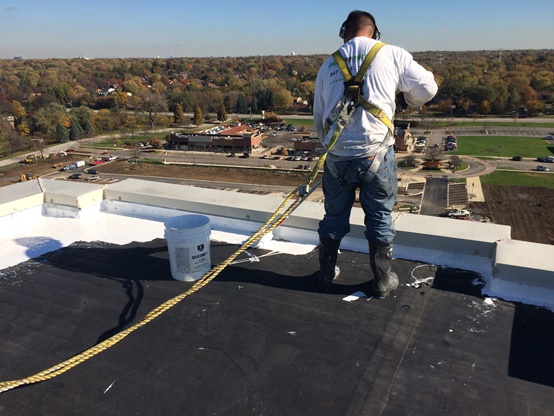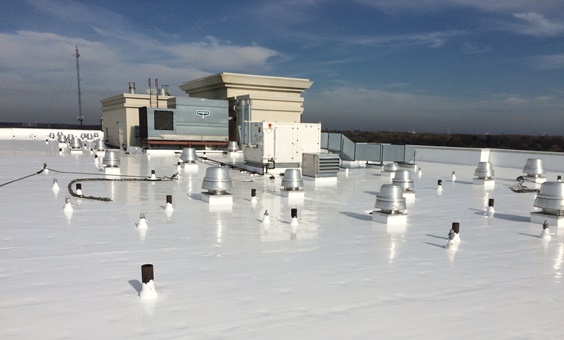Located in suburbia just outside Chicago, Illinois, the Seven Bridges Condo Association has numerous tenants paying high prices to live in a luxurious 10-story building near the nation’s third-largest city. So when building owners wanted a more efficient update to the building’s mechanically attached ethylene propylene diene monomer (EPDM) black roof, a less invasive application process was strongly preferred.
“They were pleased at the cost of doing a re-roof versus a tear-off,” said David Welte, president of roof coatings contractor GreenPROChicago. “Just imagine the amount of effort it would take to tear off that roof and the amount of distraction to the condo owners. You’d have cranes lifting stuff up and dropping stuff, and it would have been a major daily impact. This way, there was no detrimental impact to the client experience.”
Based on projected improvements to the efficiency of heating, ventilation, and air conditioning (HVAC) units, including lower summertime air-conditioning costs, a white silicone roof was chosen for the building. According to Welte, many municipalities around Chicago dictate white roofs because of “urban heat island” effects.
“The whole roof was black before, and black rubber absorbs heat,” Welte explained. “A white roof makes the most sense because it reflects the heat, which means HVAC units don’t have to run as hard. Because there’s heat exchange, there’s also less stress pulling at the various products, so the roof isn’t expanding and contracting. Silicone also offers durability due to its elasticity. It’s not going to snap or crack as much as an EPDM roof.”
The existing roof substrate was in good condition, except for minor leaking in one spot. To address this, the chosen system was Sherwin-Williams’ UNIFLEX Silicone44, which the manufacturer describes as a premium silicone rubber roof ideal for ponding water.
Collaborative Contractors
For the 30,000-square-foot (2,787.1 m2) job, Welte and a second GreenPROChicago staffer teamed up with two crew members from Hammerbrush Painting & Construction, another local contractor with a slightly different emphasis.
“They specialize in commercial building maintenance and painting, and we specialize in commercial roof coatings and do limited small paint jobs,” Welte explained. “They know a lot of the building owners that I would not know because of all the other projects they do. We have a mutual Sherwin-Williams rep that said it makes sense to reach out to these guys because they’re looking to do roof coating projects, and you’re the person with the certifications and experience in doing that. That’s when we decided to partner.”
Enhanced speed was a key benefit of the partnership, since the job was completed over 10 days in early November — just before the winter season hit in Chicago, when temperatures are frequently too low for coatings to cure properly.
“The manufacturer will only warranty [the system] if it’s put on in the proper condition,” Welte said. “Moisture and temperature are the two driving factors as to when we can apply the product, so we typically work from April through November. We were right up against the end of our November deadline, so that’s why we partnered and got more people on the roof.”

The moisture-curing silicone system was more applicator-friendly than many alternatives, based on quicker curing times. “If I had done a water-based product and we had a big rainstorm, it would have washed half the product away,” Welte said. “In six hours, the silicone is hard enough that you could have a major rainstorm and it wouldn’t affect the roof at all. It also resists water penetration much faster.”
The partnership also allowed the combined four-person crew to stay in contact with building management throughout the process and minimize any disruption to tenants. Materials and equipment were brought to the roof in buckets via elevator and stairwell, and the crew quickly got to work to try and beat the onset of winter!
Black and White Difference
Prior to each day’s assignments, crew members made sure to put on suitable personal protective equipment (PPE), including rubber gloves and safety glasses. On work within 6 feet (1.8 m) of the edge, they wore fall protection harnesses from Guardian with 50-foot (15.2 m) ropes.
The first two days of the project consisted of pressure washing the roof with a Mi-T-M 300-psi (2,068.4 kPa) power washer, and the next two days were spent applying the UNIFLEX Bond-It Wash Primer. The trick for applying the water-borne cleaner primer, Welte explained, was the use of a Wagner Power HLVP (high volume, low pressure) sprayer rather than a traditional hand-squirt bottle.
“I looked at size of the job and knowing these squirt sprayers, I knew I’d never get enough coverage, even with four or five guys, and I didn’t want a crew that big,” Welte said. “There had to be another way. With the Wagner sprayer, I could get a spray pattern of about 12 inches [30.5 cm], go back and forth, and was able to cover a large area fairly quickly.”
According to Welte, the low-viscosity primer eats away at the top molecules of the existing EPDM roof to promote better adhesion. “It opens up the pores, basically,” he said.
After one more round of power washing following primer application, the second week of the project was all about applying the new system. The silicone was applied with a 24-inch (61 cm) large-tooth squeegee from Big Rock Supply because spraying was deemed too risky for Chicago’s notoriously windy climate.
“We had wind at 10 stories up,” Welte said. “So we rolled everything out, because we didn’t want to have overspray on a building that high that we couldn’t clean.”
The silicone was dumped out at approximately 32 mils (812.8 microns) of wet film thickness (WFT), which dries into an average of 30 mils (762.0 microns) of dry film thickness (DFT), Welte said.
“We would pour a bucket of material out on the roof, then take the notched squeegee and go back and forth until there’s uniform thickness,” Welte explained. “Then you go back with a large 18-inch [45.7 cm] roller on a long pole with a [0.5-inch, 1.3-cm] nap cover and basically even it out, and make sure that it’s all uniform in terms of thickness.”
Thickness gages from UNIFLEX were used to verify the appropriate thickness levels. “Even though it’s 30 mils [762.0 microns] thick, the silicone thickens up fast,” Welte said. “It feels like you’re on a rubber roof. It cures overnight.”
The crew also embedded a 6-inch (15.2 cm) fabric into the coating in areas of the roof expected to receive more stress, such as the curbs and parapet walls. They then applied a second coating on top of the fabric. “They call it the three-course method: Putting down base, putting down fabric, and then rolling or spraying another coat of material,” Welte said, adding that work on the roof’s edges was completed with hand rollers and hand brushes. Double coating was also used on roof anchors.
Gone With the Wind
The entire job was completed within 10 days, and the client received the desired 15-year manufacturer’s warranty because the coating was applied according to all specifications.
Best of all, less observant tenants may not have even realized the crew was there!
“I heard the client was exceedingly happy,” Welte said. “Unless [tenants] saw us in the elevator, they didn’t even know we were there. It was a very low-impact kind of process.”
Winter in the Windy City began within weeks, but thanks to the partnership with Hammerbrush and careful planning, GreenPROChicago made sure its client was prepared for all the elements. Neither snow, nor rain, nor heat could slow this crew — and thanks to the duo’s hard work, the same can now be said for the building as well.
